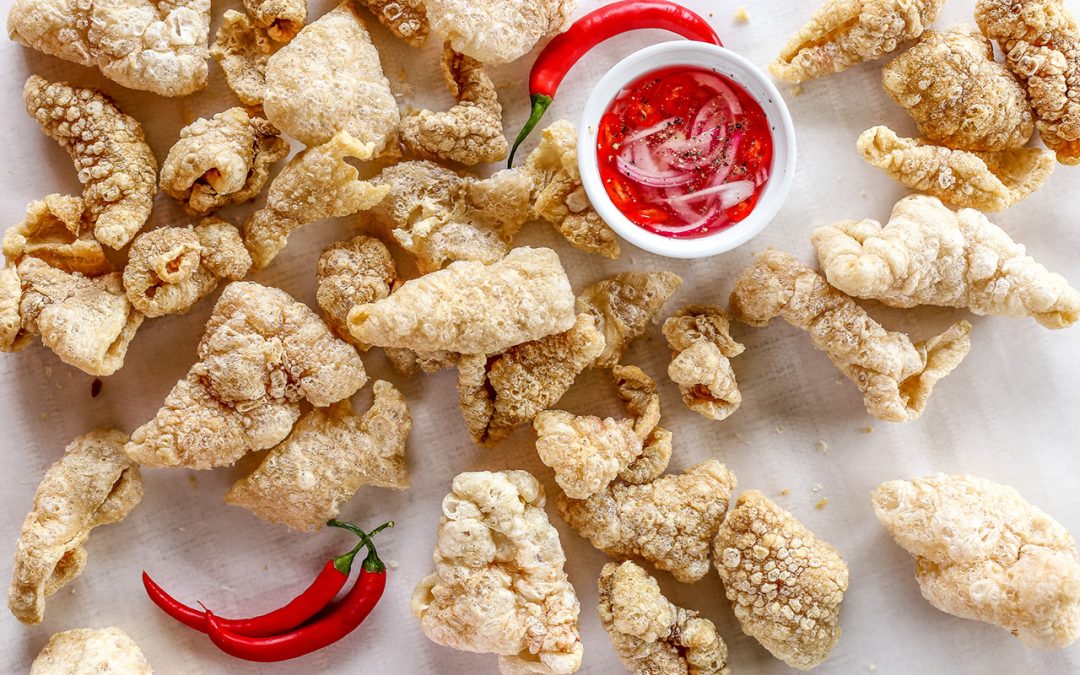
There is a type of chicharon for everyone.
Chicharon is the common term for cracklings made out of animal skin. In the Philippines, there are as many types of chicharon as the number of islands in the archipelago. Ask for chicharon in one locale and then in a neighboring town, and you’d most likely get two different versions despite their proximity.
Chicharon by form
It is classified by size or by the amount of meat in each pork rind. Chicharon bula is one of the most popular. Sometimes called chicharon tanga, this light and airy variety is made out of the skin without any meat at all. Other forms made purely of the skin include cocktail chicharon, where all fat is removed, and chicharon bilog, which is made from the belly part.
Another common form is chicharon with laman, where the pork rind has meat and fat attached to it. There is also chicharon with special laman, where the amount of meat is thicker. Chicharon bumbum has some meat but its back fat is popped, while chicharon kulurut is curly with a bit of meat.
Smaller pieces or fragmented bits of chicharon are called bitz. Chicharon pulpol or mugmog, on the other hand, is the crushed variety that is commonly used as topping for pancit palabok or ginisang monggo. There is also chicharon bingi, where the skin is slightly smoother than usual as it did not pop as much during cooking.
Chicharon by the region
Sta. Maria in Bulacan is regarded as the chicharon capital of the Philippines, so much so that a chicharon festival is held every February. Chicharon-making started in the 1920s as a backyard industry using native black pigs or baboy Tagalog. The most popular chicharon of Sta. Maria is a special backfat variety.
Also from Bulacan, but in the city of San Jose del Monte, comes a lighter and slightly fluffier variety called kulurot. From the neighboring province of Pampanga is the pititian, smaller bits of chicharon cooked in its own fat. Moving up to Vigan, one can find okilas, a purely skin chicharon that is hung to dry for 3 to 4 days then served with a dinuguan dip. Also from Ilocos is the bagnet chicharon, which is akin to its namesake pork dish but is chopped smaller and cooked to become crunchier. Similar to the bagnet is the meaty chicharon camiling of Tarlac. Moving down to Bicol, one will find agas and tacas that are chicharon varieties also cooked in their own fat.
The Visayan version of chicharon is called pinakupsan. It is made with pork belly, cut into bite-sized pieces and very meticulously cooked in its own fat until crisp. Among the Warays of Eastern Visayas, it is called pinahagas, and for the Ilonggos, this is tulapho. A very popular form of chicharon is the one from Carcar, Cebu. It is extremely crunchy and has a curled shape and a distinct popped surface. Down south in Mindanao, the most popular chicharon is from Butuan, Agusan del Norte. This version of chicharon with laman is bite-sized, firm, crunchy, and not greasy at all.
The skin is not the only part used to make chicharon. Chicharon bulaklak is another popular local treat that, as its name suggests, looks like flowers. It is made from the ruffle fat of the pig. In Cebu, it is called ginabot. Another part turned into chicharon is the intestines. This is called chicharon bituka or bagis-bagis among Ilocanos.
Chicharon by ingredient
Other meats and ingredients can also be turned into chicharon. Very popular in Tiaong, Quezon is the chiton or kibet seafood chicharon, which is made out of sea mollusk. Tilapia chicharon is also a famous product in General Santos and Sultan Kudarat. Tuna and milkfish can also be turned into chicharon.
Another chicharon product from Bulacan is the chicharon buchi or bucheron, made out of chicken crop from the bird’s esophagus. In Tuguegarao, Cagayan, the specialty chicharon is called chicharabao, which is made out of carabao skin. Meanwhile, in Bohol, a delicacy is the chichaworm, crispy superworms tossed in a spice blend. Chicharon can also be made out of mushrooms, a healthier alternative to meat-based variants. Processed chicharon is also available in the market to cater to vegans and vegetarians.


Recent Comments